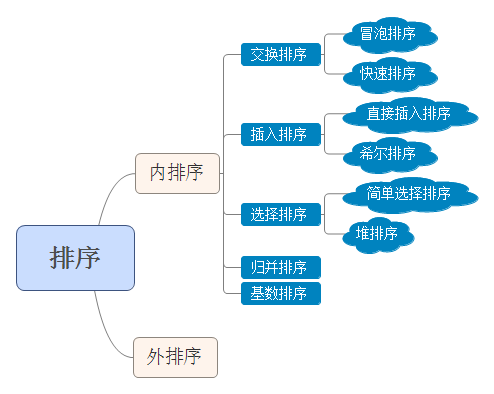本文在阅读大话数据结构这本书的基础上,结合java语言的特点,来理解排序。
| 排序方法 | 平均情况 | 最好情况 | 最坏情况 | 辅助空间 | 稳定性 |
|---|---|---|---|---|---|
| 冒泡排序 | O(n^2) | O(n) | O(n^2) | O(1) | 稳定 |
| 简单选择排序 | O(n^2) | O(n^2) | O(n^2) | O(1) | 稳定 |
| 直接插入排序 | O(n^2) | O(n) | O(n^2) | O(1) | 稳定 |
| 希尔排序 | O(nlogn)~O(n^2) | O(n^1.3) | O(n^2) | O(1) | 不稳定 |
| 堆排序 | O(nlogn) | O(nlogn) | O(nlogn) | O(1) | 不稳定 |
| 归并排序 | O(nlogn) | O(nlogn) | O(nlogn) | O(n) | 稳定 |
| 快速排序 | O(nlogn) | O(nlogn) | O(n^2) | O(logn)~O(n) | 不稳定 |
排序的基本概念
假设含有n个记录的序列为{r1,r2,……,rn},其相应的关键字分别为{k1,k2,……,kn},需确定1,2,……,n的一种排列p1,p2,……,pn,使其相应的关键字满足kp1≤kp2≤……≤kpn(非递减或非递增)关系,即使得序列成为一个按关键字有序的序列{rp1,rp2,……,rpn},这样的操作就称为排序。假设ki=kj(1≤i≤n,1≤j≤n,i≠j),且在排序前的序列中ri领先于rj(即i<j)。如果排序后ri仍领先于rj,则称所用的排序方法是稳定的;反之,若可能使得排序后的序列中rj领先ri,则称所用的排序方法是不稳定的。
内排序与外排序:根据在排序过程中待排序的记录是否全部被放置在内存中。内排序是在排序整个过程中,待排序的所有记录全部被放置在内存中。外排序是由于排序的记录个数太多,不能同时放置在内存,整个排序过程需要在内外存之间多次交换数据才能进行。
对于内排序来说,排序算法的性能主要是受三个方面影响:时间性能;辅助空间;算法的复杂性。
排序的结构图如下:

交换排序
冒泡排序
包含传统冒泡和优化冒泡两种方式实现
1 | public class Sort { |
快速排序
包含递归和尾递归优化实现
1 | /** |
插入排序
直接插入排序
1 | /** |
希尔排序
1 | /** |
选择排序
简单选择排序
1 | /** |
堆排序
1 | /** |
归并排序
包含递归和非递归实现
1 | /** |
基数排序
基于两种不同的排序顺序,我们将基数排序分为LSD(Least significant digital)或MSD(Most significant digital),LSD的排序方式由数值的最右边(低位)开始,而MSD则相反,由数值的最左边(高位)开始。注意一点:LSD的基数排序适用于位数少的数列,如果位数多的话,使用MSD的效率会比较好。
http://www.cnblogs.com/Braveliu/archive/2013/01/21/2870201.html
代码实现(包含LSD和MSD两种实现方式)
1 | /** |

